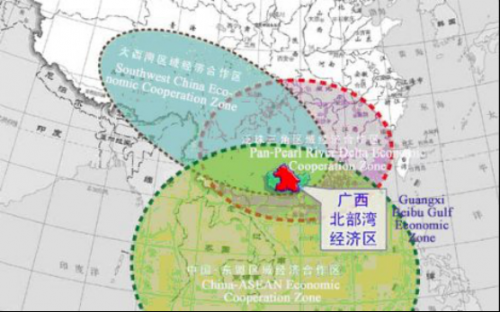Guangxi Beibu Gulf Economic Zone consists of four cities, which are Nanning, Beihai, Qinzhou and Fangchenggang city, covering an area of 42,500 square kilometers, with a population of over 13 million. Transportation and logistics networks of Yulin and Chongzuo are also included in the economic zone.
Economic development
Established in March 2006, the economic zone has shown remarkable achievements after a decade of development, including rapid growth, booming modern industries, infrastructure improvement and rise of large ports.
The economic zone has become a leading force of Guangxi's economic development, a growth engine of China's western area, a bright spot of coastal border development and major path to cooperate with the Association of Southeast Asian Nations (ASEAN).
Economic Indicators of Guangxi Beibu Gulf Economic Zone in 2015
|
Economic Indicators of Guangxi Beibu Gulf Economic Zone in 2015 |
|||||
|
Area |
GDP(Unit:100 mln) |
Ranking |
Growth rate (%) |
Ranking |
|
|
Total in Guangxi |
16,803.12 |
|
8.1 |
|
|
|
Sum of four cities |
5,867.32 |
|
9.1 |
|
|
|
Sum of six cities |
7,996.27 |
|
9 |
|
|
|
Nanning |
3,410.09 |
1 |
8.6 |
4 |
|
|
Beihai |
892.08 |
8 |
11.4 |
1 |
|
|
Fangchenggang city |
620.72 |
11 |
10.2 |
2 |
|
|
Qinzhou |
944.42 |
7 |
8.4 |
5 |
|
|
Yulin |
1,446.13 |
4 |
8.9 |
3 |
|
|
Chongzuo |
682.82 |
10 |
8 |
8 |
|
(Source: Xinhua Silkroad Database, http://www.bbw.gov.cn)
By the end of 2015, the 14 key industrial parks in the economic zone have developed more than 200 square kilometers of the 742 square kilometers total planning area. In 2015, the industrial parks' total output valued at 672.981 billion yuan (including trade). Among them, the Pingxiang Integrated Free Trade Zone, Nanning New & High-tech Industrial Development Zone realized more than one hundred billion yuan of output, and five other parks recordedmore than 50 billion yuan of output value, with a total of 490 enterprises reporting over one hundred million yuan of output value.
|
14 Major Industrial Parks in Guangxi Beibu Gulf Economic Zone |
||
|
|
Planning area (sq km) |
Main Industries |
|
Guangxi ASEAN Economic and Technological Development Zone |
180 |
Food, textile |
|
Naning Liujing Industrial Park |
65 |
Chemical products, paper pulp, agricultural products processing |
|
Nanning New & High-tech Industrial Development Zone |
18 |
Pharmaceutical and biological engineering, electronic information, animation industry, auto parts and machinery |
|
National Nanning Economic & Technological Development Area |
11 |
Mechanical and electrical manufacturing, food processing, information technology, biological medicine |
|
CEC Beihai Industrial Park |
31 |
Electronic information, biological medicine, machinery manufacturing, food processing, new energy and new materials |
|
Beihai TieshangangIndustrial Park |
132 |
Petrochemical, metallurgical |
|
Fangchenggang Grand Southwest Port Industrial Zone |
17.2 |
Phosphoric acid, steel structure, machinery and equipment |
|
Fangchenggang QishaIndustrial Park |
92.68 |
Iron and steel, metallurgy, nuclear power |
|
China PetrochemicalIndustry Park (Qinzhou) |
35.8 |
Petrochemical, new materials, inorganic chemical, biological chemical industry |
|
Qinzhou Integrated Logistics Processing Zone |
18 |
Automobile manufacturing, equipment manufacturing, marine engineering |
|
China-Malaysia QinzhouIndustrial Park |
55 |
Integrated manufacturing, information technology, modern service industry |
|
Guangxi Qinzhou FreeTrade Port Area |
10 |
Vehicle imports, bonded warehousing, foreign trade, international procurement, port operations |
|
Yulin Longtan Industrial Park |
30 |
Non-ferrous metal smelting, processing of renewable resources |
|
Pingxiang Integrated Free Trade Zone |
8.5 |
Mechanical and electrical, electronic information, new materials and environment-friendly processing industry, logistics, international trade |
(Source: Xinhua Silkroad Database, http://www.bbw.gov.cn)
Geographic Advantages

(Chart : Geographic position of Guangzi Beibu Gulf Economic Zone)
Guangxi Beibu Gulf Economic Zone is located in the area where the south China economic circle, Pan-Pear River Delta Economic Cooperation Zone and the China-ASEAN economic circle overlap each other.
It borders Hong Kong and Macao to the east, sits back to the southwest China and faces Southeast Asia.
The Beibu Gulf Economic Zone boasts 1,629 kilometers of coastline, 267 kilometers of which could be included in ports planning. It's rich in marine, mining, tourism, water, agriculture and forestry resources, suitable for developing modern port cluster and heavy industry cluster.
Preferential policies
Guangxi Beibu Gulf Economic Zone enjoys favorable policies for developing the west of China, opening up the coastal areas, supporting ethnic minority autonomous regions and opening up border areas. Moreover, the planning of Guangxi Beibu Gulf Economic Zone development introduced in 2008 gave a series of preferential policies. Guangxi government has also introduced various preferential policies in taxation, land using, and industry development.
The preferential policies mainly fall in five aspects:
1. Policy for supporting comprehensive reforms. The planning mentioned above says comprehensive reforms in administrative management system, market system, land management system, transformation government function, economic zone management and the financing system should be promoted.
2. Policy for supporting deployment of major projects. The central government has given favorable policies on planning, registration and approval for major projects and encourages the eastern region to participate in the integration with the economic zone.
3. Policy for supporting bonded logistics system construction. The central government encourages areas with suitable conditions to set up bonded port areas, comprehensive bonded zones and bonded logistics centers.
4. Policy for supporting financial reform. China supports establishment of local banks, industry investment funds and venture capital funds, and encourages expanding the scale of the enterprise bond issuance in the economic zone.
5. Policy for supporting opening up and international cooperation. China encourages the economic zone to establish new opening-up and cooperative mechanism in Pan-Beibu Economic Zone development and speed up implementation of cooperation projects.




 A single purchase
A single purchase








